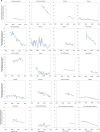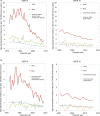Global time trends in the incidence of esophageal squamous cell carcinoma
- PMID: 29950901
- PMCID: PMC6016013
- DOI: 10.2147/CLEP.S166078
Global time trends in the incidence of esophageal squamous cell carcinoma
Abstract
Background and aims: Esophageal squamous cell carcinoma (ESCC) is the dominant histological type of esophageal cancer worldwide (90%). We aimed to provide an update of the global temporal trends in the incidence of ESCC.
Methods: Incidence data for ESCC were collected from 30 well-established cancer registries from 20 countries in Europe, Northern America, Australia, or Asia for 1970-2015. Time trends in annual age-standardized incidence rates of ESCC were assessed using joinpoint analysis and log-linear regression. Age-period-cohort analysis was used to estimate the influence of age, calendar-period, and birth-cohort on the observed time trends in incidence.
Results: The age-standardized incidence rates of ESCC varied more than eightfold in men and sevenfold in women across populations. In 2012, the highest rate of ESCC in men was observed in Nagasaki, Japan (9.7/100,000 person-years) and in women in Scotland (2.7/100,000 person-years). In men, the incidence decreased globally during the study period, as well as during the last few years. In women, the incidence increased in Japan (three regions), the Netherlands, New Zealand, Norway, and Switzerland, whereas it stabilized or decreased in other populations. Among ethnic groups in the United States, black men and women had more pronounced decreases in incidence than other groups. Generally, birth-cohort effects were stronger determinants of incidence trends than calendar-period effects.
Conclusion: In men, the global ESCC incidence has decreased over time. In women, the incidence trends vary across populations, and the rates have increased in some countries. Changes in the prevalence of tobacco smoking and alcohol consumption may have contributed to these time trends.
Keywords: epidemiology; esophageal cancer; esophageal neoplasm; occurrence; worldwide.
Conflict of interest statement
Disclosure All authors report no conflicts of interest in this work.
Figures





References
-
- Arnold M, Soerjomataram I, Ferlay J, Forman D. Global incidence of oesophageal cancer by histological subtype in 2012. Gut. 2015;64(3):381–387. - PubMed
-
- Lagergren J, Smyth E, Cunningham D, Lagergren P. Oesophageal cancer. Lancet. 2017;390(10110):2383–2396. - PubMed
-
- Xie SH, Lagergren J. Time trends in the incidence of oesophageal cancer in Asia: variations across populations and histological types. Cancer Epidemiol. 2016;44:71–76. - PubMed
-
- Thrift AP, Whiteman DC. The incidence of esophageal adenocarcinoma continues to rise: analysis of period and birth cohort effects on recent trends. Ann Oncol. 2012;23(12):3155–3162. - PubMed
LinkOut - more resources
Full Text Sources
Other Literature Sources

